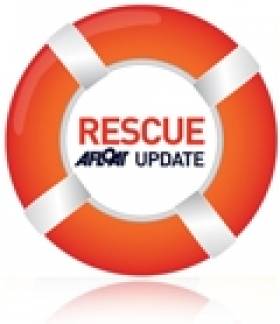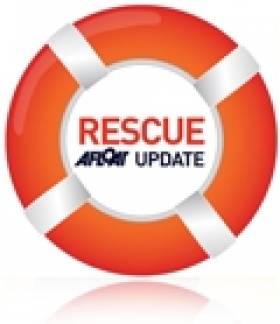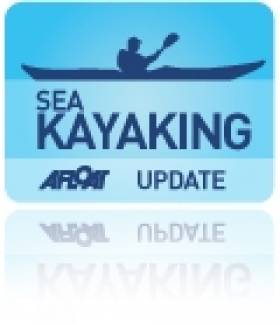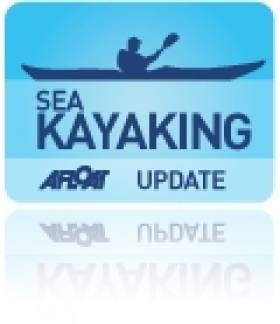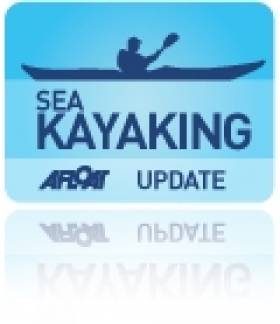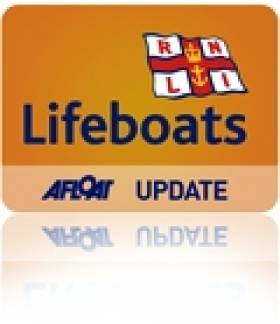Displaying items by tag: RNLI
Galway Lifeboat Launches Twice with Boats in Difficulty
Galway RNLI lifeboat was called out to two separate incidents on Galway Bay yesterday when two boats got into difficulty, one near Barna with three people on board and the other near Galway Docks.
The first incident involved a 30ft sailing boat, which was spotted drifting towards the shore between Rinmore Beach and Galway Docks, known as the Forty Acres. The boat was unoccupied and is understood to have broken its moorings near Mutton Island. The alarm was raised by a passing sailing boat and the Irish Coastguard tasked Galway lifeboat to the scene at approximately 10.40am.
The boat had run up on rocks close to the shore however the lifeboat crew of Helmsman John Byrne, David Oliver and Sean King managed to rig up a tow and bring the boat safely to Galway Docks.
The second callout happened near Barna at approximately 1.35pm. Three people in a 22ft open-deck fishing boat got into difficulty when the engine failed and the boat started drifting onto rocks half a mile west of Barna.
Two of the three people on board were wearing lifejackets and decided to swim for it as the boat veered towards rocks about 500 metres from the shore.
The Irish Coastguard tasked several rescue units to the scene including the Shannon Rescue Helicopter, the Aran Islands lifeboat, Galway lifeboat, and the Irish Coastguard Rescue Unit from Rosaveel. Two Galway Bay Sailing Club rescue boats already out at the club's regatta came across to assist in the rescue when they heard the distress call.
The three people made it safely ashore where Gardai from Salthill were waiting. They did not require medical attention. Attempts were made to take the boat in tow but it wasn't feasible and Galway lifeboat was stood down. The crew on the second callout were Helmsman David Oliver, John Byrne and Olivia Byrne.
Related Safety posts
RNLI Lifeboats in Ireland
Safety News
Rescue News from RNLI Lifeboats in Ireland
Coast Guard News from Ireland
Water Safety News from Ireland
Marine Casualty Investigation Board News
Marine Warnings
New Rescue Boat Launched for Ballybunion Sea and Cliff Rescue Service
Ballybunion Sea & Cliff Rescue Service in North Kerry officially launched their new Atlantic 75 rescue boat yesterday.
After three years of negotiations and build time the 7.5 metre Rigid Inflatable Boat arrived earlier this year. After several months of sucessful sea trials the boat entered full active service at the weekend, althought its first call out in anger occured last week to tow a stricken vessel that had lost engine power.
The unit depends fully on public donations and a small government grant to run the unit each year at a cost of over €40,000.
The boat was officially named by Derek Nagle, a member of the Duggan family in Ballybunion who have long been assosiated with the unit as supporters. The vessel was named the "Tommy C" after Tommy Duggan and his Wife Clara. The previous boat, an Atlantic 21 was named the "Clara T".
Related Safety posts
RNLI Lifeboats in Ireland
Safety News
Rescue News from RNLI Lifeboats in Ireland
Coast Guard News from Ireland
Water Safety News from Ireland
Marine Casualty Investigation Board News
Marine Warnings
Red Bay Crew in Line for '999 Hero Award'
Great to read this morning that the Red Bay RNLI lifeboat crew are in line for an award in the Belast Telegraph's 'Making The Difference Awards'. It is a new scheme to recognise those heroes across Northern Ireland whose stories never get told. The Red Bay lifeboat dramatically rescued a brother and sister from rocks on the north Antrim coast at the start of August. We reported it HERE.
The pair were stranded while walking in the beautiful but dangerous boulder field at Fair Head rock. After raising the alarm the crew quickly launched the Atlantic 85 lifeboat Geoffrey Charles and battled through rough waters to reach them.
In order to get to the frightened pair, a 'lifeline' had to be created with a rope. Lifeboat crew member John Walsh had to bravely put on a drysuit and lifejacket, enter the water and swim out to them.
Helmsman Paddy McLaughlin, who has been a member of the RNLI since he was 17, said it was a difficult operation.
"It was a tricky rescue, it took about three hours all in," he said.
"It was just hard to reach them because of the location of the rocks. But we got them safely ashore."
Mr McLaughlin said they are "just doing what they are trained to do".
"We aren't in it for the glory. As soon as we get the call the training just kicks in," he said.
"I suppose you don't think about it."
More on the awards HERE.
Related Safety posts
RNLI Lifeboats in Ireland
Safety News
Rescue News from RNLI Lifeboats in Ireland
Coast Guard News from Ireland
Water Safety News from Ireland
Marine Casualty Investigation Board News
Marine Warnings
Bundoran RNLI Pushes the Boat Out
The boat push will start on Donegal Road in Ballyshannon at noon and members of the lifeboat crew will have buckets with them on the route for people to make a donation.
The fundraising drive comes as Bundoran RNLI recently received a new state of the art Atlantic 85 lifeboat. The new lifeboat can carry a fourth crewmember and has more room for casualties. It can also reach speeds of up to 35 knots in responding to an emergency.
Commenting on the fundraiser, lifeboat press officer Colm Hamrogue said, "The lifeboat crew wanted to do something a bit different to raise funds for the station. Many people have done a bed push but not too many people have done a boat push, which makes sense for a lifeboat station. Our volunteer crew count on the generous support of the public to ensure that the RNLI can continue to provide all year search and rescue coverage and we hope to get lots of support on Saturday."
Related Safety posts
RNLI Lifeboats in Ireland
Safety News
Rescue News from RNLI Lifeboats in Ireland
Coast Guard News from Ireland
Water Safety News from Ireland
Marine Casualty Investigation Board News
Marine Warnings
Swimming from Rathlin to Ballycastle for the RNLI
Gary explained further 'The swim is from Rathlin to Ballycastle and is planned for the weekend of 4-5 September. I won't be wearing a wetsuit and the swim is approximately 7 miles. Water temperature will be approx. 12 degrees and the challenge isn't so much the distance as the large number of Lions Mane jellyfish which lie between Rathlin and Ballycastle and the very strong and treacherous currents which swirl around the island. I am doing the swim for RNLI in memory of my friend and training partner, Ciaran McGinn who completed the endurance swim in 2007 and raised funds for his charity, Ballycastle RNLI. Training has gone well and I've done a 15K open water swim, Portrush to Portstewart two-way and a swim from Ballycastle to Fairhead in preparation for the event. I've been stung by the jellies and got my body used to the chilly waters. The swim to Fairhead last weekend opened my eyes to the strong currents when I made no progress for 90 mins on way back to Ballycastle and had to jump out onto road and hitch a lift back into town! Hopefully the tides will be kinder to me on day of swim. I'll be accompanied by Portrush kayaker Andrew Bingham who will follow the rib and provide me with an energy drink every hour. In accordance with ILDSA rules, at no time will I be permitted to touch the boat or kayak. Donations can be made online at justgiving.com/gary-knox and there are collection boxes in the shops along the prom in Ballycastle. In the event of bad weather, swim will be rescheduled for mid Sept or October. The swim has a low success rate and is very dependent on conditions and tides on the day'
Gary who is a French teacher, 38, and swimming coach at CAI who took up sea swimming in 2008 and lives in Aghadowey. On Sunday he came down to meet the crew and tell them about the swim.
Judy Barr Lifeboat Press Officer said,
This is an amazing feat for anyone to attempt and we are delighted that Gary is raising funds for our volunteer crews and the Station who depends on donations to keep our two boats available for rescues at sea.'
Search for Missing Kayaker Ends After Women's Body Recovered
The search from Lleyn to Morfa Nefyn, Fort Belan and Llanddwyn involved RNLI all weather lifeboats from Holyhead and Porth Dinllaen, two helicopters from the RAF at Valley together with a North Wales Police helicopter and Coastguard Rescue Teams from Aberdaron, Porth Dinllaen and Llandwrog. It resumed after a red Avocet kayak, like the one used by missing female kayaker, was found on the beach at Morfa Nefyn on the Lleyn peninsular this morning.
Search Resumes After Missing Kayak Located
Early this morning a red Avocet kayak answering the description of the one used by missing female kayaker, Elizabeth Ashbee, a member of Shrewsbury Kayak Club, was found on the beach at Morfa Nefyn on the Lleyn peninsular. There is no apparent damage to the craft. It has now been confirmed that the craft was the one being used by Ms Ashbee.
The North Wales Police were informed who have now inspected the vessel and the maritime search and rescue operation has now resumed. The family of the missing woman has been informed.
Holyhead RNLI all weather lifeboat was asked to resume its search, and two helicopters from the RAF at Valley together with a North Wales Police helicopter are conducting a shoreline search in Caernarfon Bay, particularly from Lleyn to Morfa Nefyn, Fort Belan and Llanddwyn.
Coastguard Rescue Teams from Aberdaron, Porth Dinllaen and Llandwrog are also engaged in searching the coastline in the Bay.
Holyhead Coastguard have been broadcasting pan signals into area alerting shipping to the resumed search.
The weather on scene is a slight sea, with good visibility and south westerly winds of between 10 – 12 knots.
Ms Ashbee, wearing a dry suit and a buoyancy aid went missing Sunday afternoon in her kayak in poor weather and was last seen heading through rocks at Ynys Feurig, or Starvation Island, close to Rhosneigr. An area of up to 60 square miles has now been covered in the search.
Members of the Shrewsbury Kayak Club have also arrived on scene and are assisting Coastguard units in the search.
Irish Sea Kayaker Feared Dead
A kayaker is feared dead after disappearing in treacherous conditions off the coast of Anglesey on the far side of the Irish Sea. The 53-year-old mother-of-two was separated from four other canoeists between Rhosneigr and Rhoscolyn as they were battered by waves and heavy winds at around 2.30pm on Sunday.
The rest of the party were washed ashore but the woman from Shrewsbury has not been seen since then.
Her disappearance saw a major land and sea search launched with the police and RAF Valley helicopters, three lifeboats and dozens of coastguard officers scouring the area.
They were yesterday joined by a fixed wing aircraft and SARDA search and rescue dogs who were searching the coastline in case she had been washed up injured onto the shore.
The chance of her being found alive was fading with every passing hour but the coastguard said they had not given up hope. More HERE from the North Wales Daily Post.
Dun Laoghaire Lifeboats Assist Swamped Yacht
Both lifeboats at Dun Laoghaire RNLI station were launched this afternoon when a 20 foot yacht with two persons on board got into difficulty close to a rocky shoreline on Dublin Bay.
The incident occurred around 5pm when the Flying 15 keelboat became swamped by the choppy conditions in the area known as Scotman's Bay between Dun Laoghaire and Sandycove. A sea-angling boat, the Brandon Lisa and a local rigid inflatable (RIB) went to the assistance of the casualty.
Volunteer crews of both lifeboats were paged by the Irish Coastguard service's 'MRCC Dublin' at 5.08pm and launched 12 minutes later.
Arriving at the nearby scene, the two occupants were trying to drop the sails and secure their equipment. Both were wearing buoyancy aids and were
uninjured.
The inshore lifeboat assisted preparing the casualty vessel for towing by the RIB while the All-weather lifeboat 'Anna Livia' provided an escort to the inner-coal harbour in Dun Laoghaire where the boat was brought ashore.

Lifeboat Rescues Flying Fifteen Crew
A rescue operation to recover a Flying fifteen keelboat and its two crew is underway on Dublin bay this evening. The 20-foot sailing boat capsized in strong north westerly winds in Scotsman's Bay. Both Dun Laoghaire's inshore and offshore lifeboats and a local RIB is at the scene.
Related Safety posts
RNLI Lifeboats in Ireland
Safety News
Rescue News from RNLI Lifeboats in Ireland
Coast Guard News from Ireland
Water Safety News from Ireland
Marine Casualty Investigation Board News
Marine Warnings



























